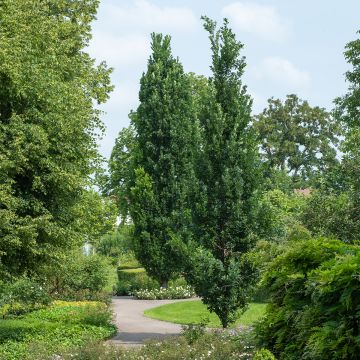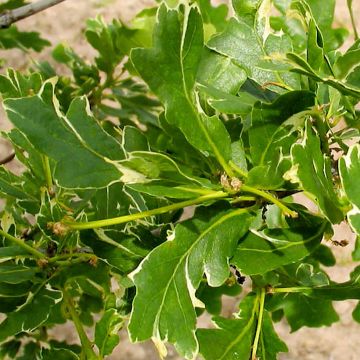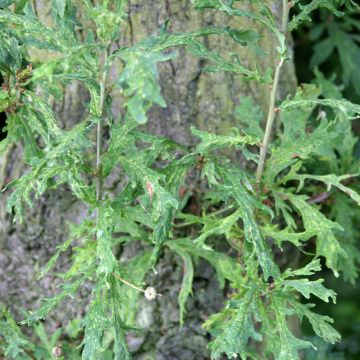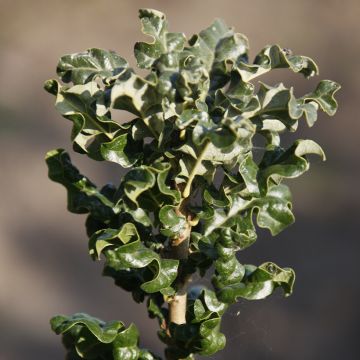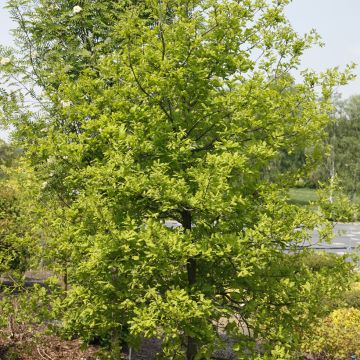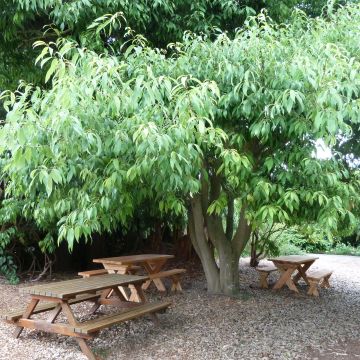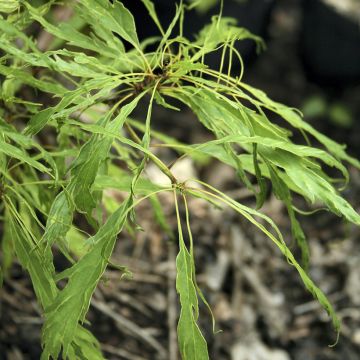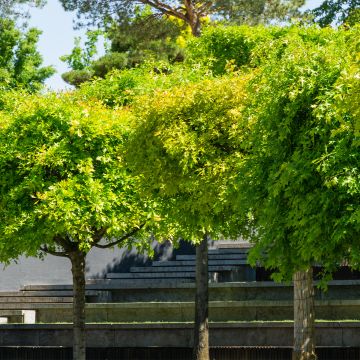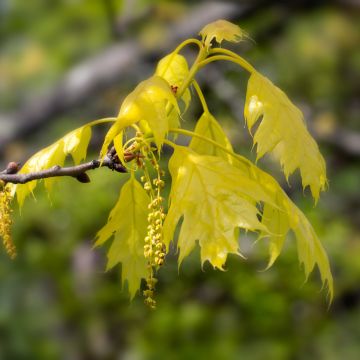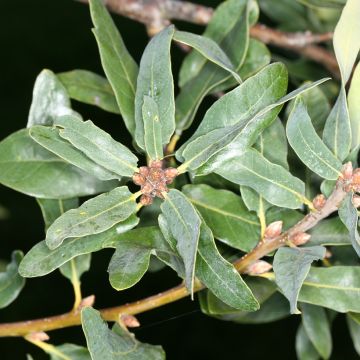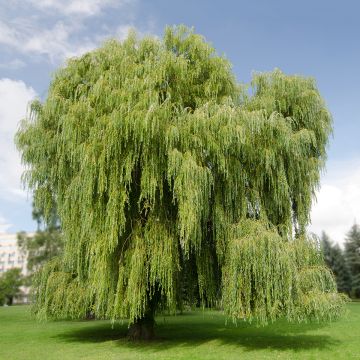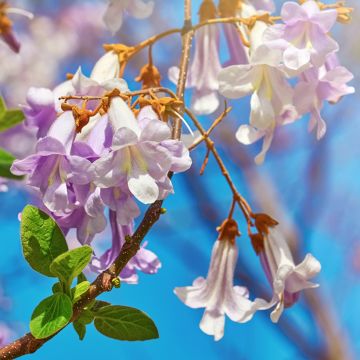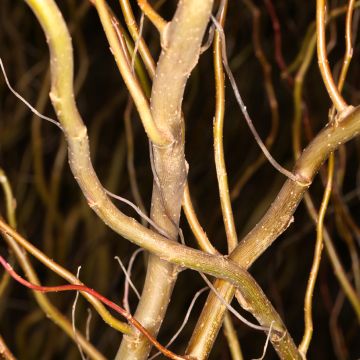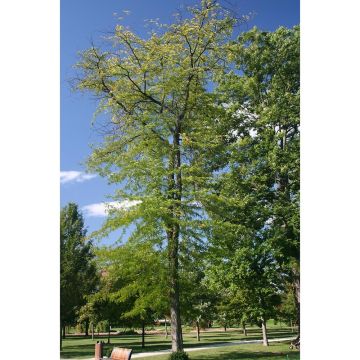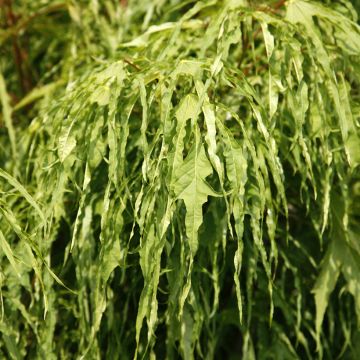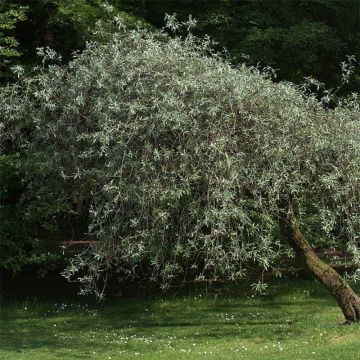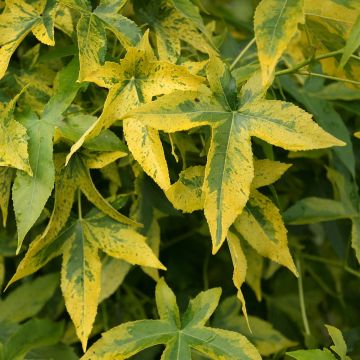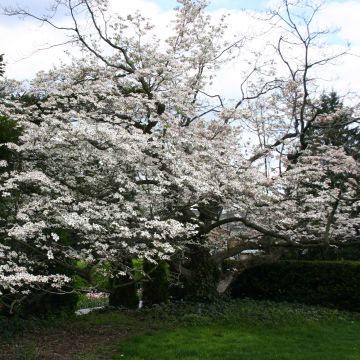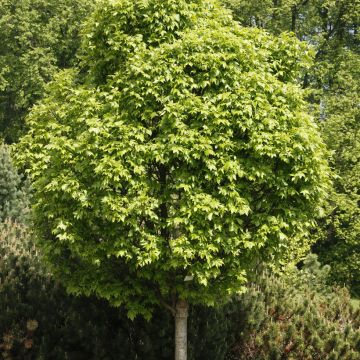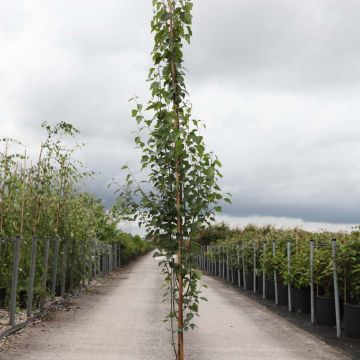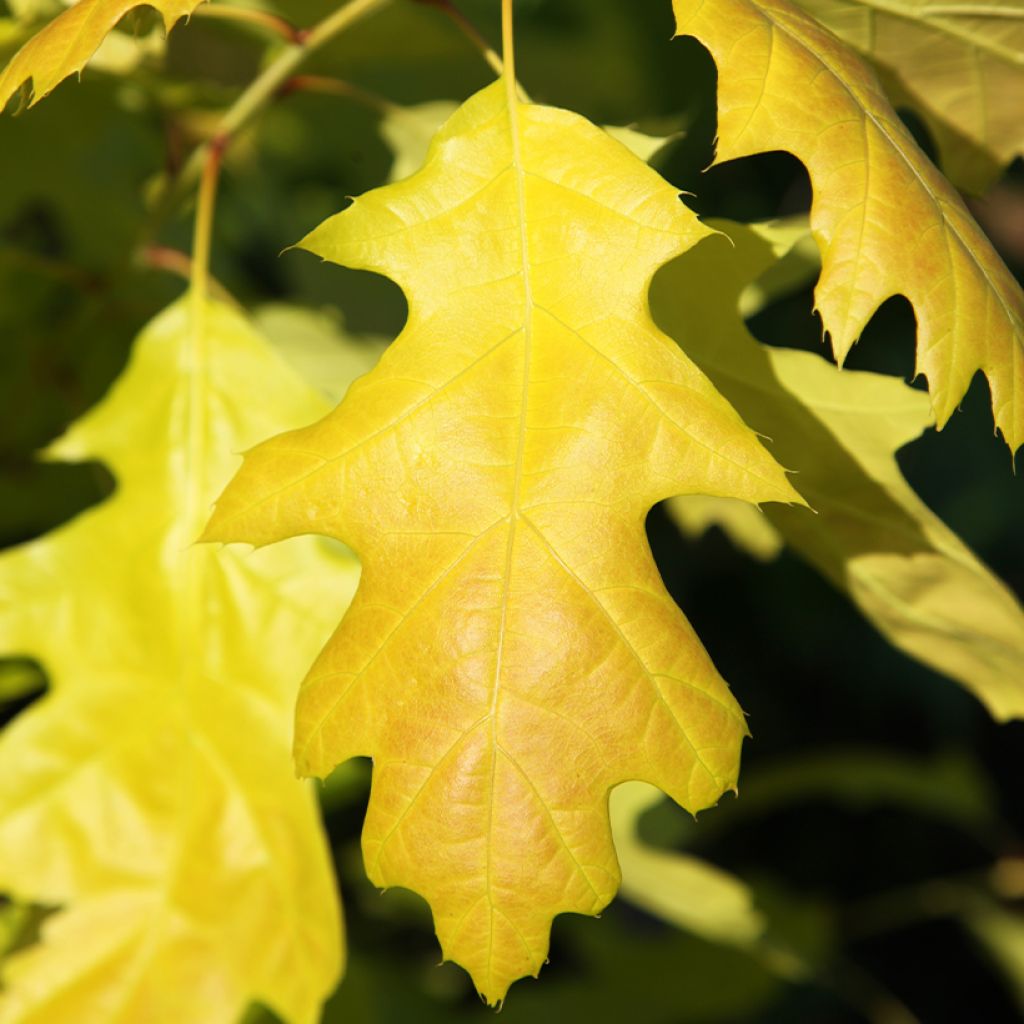

Quercus rubra Boltes Gold - Red Oak
Quercus rubra Boltes Gold - Red Oak
Quercus rubra Boltes Gold
Northern Red Oak, Red Oak
This item cannot be shipped to the selected country
Oversize package delivery charge from €6.90
More information
Schedule delivery date,
and select date in basket
This plant carries a 24 months recovery warranty
More information
We guarantee the quality of our plants for a full growing cycle, and will replace at our expense any plant that fails to recover under normal climatic and planting conditions.
Oversize package: home delivery by special carrier from €6.90 per order..
Express home delivery from €8.90.
Does this plant fit my garden?
Set up your Plantfit profile →
Description
Quercus rubra 'Boltes Gold', also known as the Golden American Red Oak, is a rare variety appreciated for its colourful foliage and moderate growth. With a relatively fast growth rate, this semi-deciduous tree typically reaches a height of 10 to 12 metres, making it suitable for medium-sized gardens with its ornamental value. The ever-changing colour of its foliage, starting with yellow in spring, turning to light green in summer, and finally becoming reddish-orange in autumn, easily adds vibrancy to any garden. This variety thrives in sunny locations, which enhances its golden colour. Tolerant to urban pollution and very hardy, it is an original tree that flourishes in humus-bearing and moist, neutral to acidic, non-calcareous soils. When planted in a suitable location, it becomes an attractive and low-maintenance specimen all year round.
Quercus rubra or borealis, commonly known as the American Red Oak, is a tree belonging to the Fagaceae family, just like the beech and chestnut trees. This large tree, native to the eastern part of North America, is particularly widespread in the state of New Jersey in the United States and the Prince Edward Island province in Canada. It was introduced to Europe in 1724 for reforestation purposes, as its rapid growth, reaching a height of 20 to 30 metres at maturity (within 20 to 30 years), made it more attractive than European oaks at the time. However, this botanical use should not distract us from its classic beauty. It has a symmetrical pyramidal habit, a straight trunk, a well-developed canopy, and upright massive branches covered with large leaves measuring between 12 and 22 cm in length. The leaves turn red in autumn and then brown, persisting on the tree throughout part of the winter (marcescent foliage). The branches can grow up to one metre per year during the first ten years. Some specimens can reach 50 metres in height and have a lifespan of over 250 years.
The 'Boltes Gold' cultivar distinguishes itself from the species by its more moderate development and its yellow-golden foliage in spring. At maturity, it can reach a height of 8 to 12 metres with a spread of 7 to 9 metres, and its canopy takes on a rounded and spreading shape. The very straight trunk is covered with smooth greyish bark. The branches divide into numerous small reddish-brown twigs. In early spring, the buds initially reveal young orange-coloured fuzzy leaves. The leaves, with 4 or 5 angular lobes can be more or less spiny and turn golden yellow in spring and then light green in summer. They eventually take on shades of orange to bright red in autumn. In late autumn, they turn brown and persist on the twigs throughout winter. This American oak produces early flowers in early spring (April-May) on the current year's young twigs, which then give rise to decorative brown-red acorns. These acorns, about 2 cm in diameter, mature in the second year. They are held by a scaly cup and develop on short stalks.
The 'Boltes Gold' American Red Oak is a medium-sized tree with an elegant habit that grows in a balanced manner. Thanks to its foliage, which changes colour over time, it brings a unique touch to any space. It is a robust tree that can withstand winter cold, tolerating temperatures as low as -25°C. It grows faster in fertile and moderately moist soil. Alkaline limestone soils are not suitable for this tree species. It can be planted alone as a specimen tree to admire its stature or in groups to create a grove with filtered shade. It is recommended for large gardens, parks, streets, squares, and large lawns in urban areas. Why not accompany the 'Boltes Gold' American Red Oak with trees that have similar requirements, such as maples, beeches, ashes, lindens, or even sophoras, to bring diversity in form, colour, and architecture to a large space. Ground-cover plants suitable for shaded conditions and slightly moist soils, such as Japanese Spurge (Pachysandra terminalis), Algerian Ivy (Hedera algeriensis Algerian Bellecour), Greater Periwinkle (Vinca major), or Lady Fern (Athyrium filix-femina), can be planted at its base. Due to its good tolerance to pruning, it is also suitable for bonsai training.
Report an error about the product description
Plant habit
Flowering
Foliage
Botanical data
Quercus
rubra
Boltes Gold
Fagaceae
Northern Red Oak, Red Oak
Cultivar or hybrid
Other Oak
Planting and care
Plant your Quercus rubra Boltes Gold in autumn or winter, outside of frost periods. Choose a sunny, open location with deep soil and keep in mind the space it will take up in the long term. This tree does not tolerate calcareous and/or alkaline soils well. It is very hardy and thrives in all types of soil, even clayey, as long as it is not too compact or suffocating. It is resistant to drought and extreme temperature variations, including severe cold and scorching heat. If necessary, create a drainage pit with stones if your soil is suffocating. If your soil is poor, adding leaf compost will be beneficial. Water regularly during the summer following planting and be careful to avoid prolonged droughts for another year; mulching can help keep the soil moist and space out watering. It is perfectly frost-resistant. Stake young plants and then let nature take its course. It is recommended to plant it at a sufficient distance from buildings as its root system is powerful. Pruning is unnecessary, except for young trees that are not growing in a balanced manner. In February, before the start of vegetation, remove dead or diseased wood that disrupts the tree's shape.
Planting period
Intended location
Care
This item has not been reviewed yet - be the first to leave a review about it.
Trees and large shrubs
Haven't found what you were looking for?
Hardiness is the lowest winter temperature a plant can endure without suffering serious damage or even dying. However, hardiness is affected by location (a sheltered area, such as a patio), protection (winter cover) and soil type (hardiness is improved by well-drained soil).

Photo Sharing Terms & Conditions
In order to encourage gardeners to interact and share their experiences, Promesse de fleurs offers various media enabling content to be uploaded onto its Site - in particular via the ‘Photo sharing’ module.
The User agrees to refrain from:
- Posting any content that is illegal, prejudicial, insulting, racist, inciteful to hatred, revisionist, contrary to public decency, that infringes on privacy or on the privacy rights of third parties, in particular the publicity rights of persons and goods, intellectual property rights, or the right to privacy.
- Submitting content on behalf of a third party;
- Impersonate the identity of a third party and/or publish any personal information about a third party;
In general, the User undertakes to refrain from any unethical behaviour.
All Content (in particular text, comments, files, images, photos, videos, creative works, etc.), which may be subject to property or intellectual property rights, image or other private rights, shall remain the property of the User, subject to the limited rights granted by the terms of the licence granted by Promesse de fleurs as stated below. Users are at liberty to publish or not to publish such Content on the Site, notably via the ‘Photo Sharing’ facility, and accept that this Content shall be made public and freely accessible, notably on the Internet.
Users further acknowledge, undertake to have ,and guarantee that they hold all necessary rights and permissions to publish such material on the Site, in particular with regard to the legislation in force pertaining to any privacy, property, intellectual property, image, or contractual rights, or rights of any other nature. By publishing such Content on the Site, Users acknowledge accepting full liability as publishers of the Content within the meaning of the law, and grant Promesse de fleurs, free of charge, an inclusive, worldwide licence for the said Content for the entire duration of its publication, including all reproduction, representation, up/downloading, displaying, performing, transmission, and storage rights.
Users also grant permission for their name to be linked to the Content and accept that this link may not always be made available.
By engaging in posting material, Users consent to their Content becoming automatically accessible on the Internet, in particular on other sites and/or blogs and/or web pages of the Promesse de fleurs site, including in particular social pages and the Promesse de fleurs catalogue.
Users may secure the removal of entrusted content free of charge by issuing a simple request via our contact form.
The flowering period indicated on our website applies to countries and regions located in USDA zone 8 (France, the United Kingdom, Ireland, the Netherlands, etc.)
It will vary according to where you live:
- In zones 9 to 10 (Italy, Spain, Greece, etc.), flowering will occur about 2 to 4 weeks earlier.
- In zones 6 to 7 (Germany, Poland, Slovenia, and lower mountainous regions), flowering will be delayed by 2 to 3 weeks.
- In zone 5 (Central Europe, Scandinavia), blooming will be delayed by 3 to 5 weeks.
In temperate climates, pruning of spring-flowering shrubs (forsythia, spireas, etc.) should be done just after flowering.
Pruning of summer-flowering shrubs (Indian Lilac, Perovskia, etc.) can be done in winter or spring.
In cold regions as well as with frost-sensitive plants, avoid pruning too early when severe frosts may still occur.
The planting period indicated on our website applies to countries and regions located in USDA zone 8 (France, United Kingdom, Ireland, Netherlands).
It will vary according to where you live:
- In Mediterranean zones (Marseille, Madrid, Milan, etc.), autumn and winter are the best planting periods.
- In continental zones (Strasbourg, Munich, Vienna, etc.), delay planting by 2 to 3 weeks in spring and bring it forward by 2 to 4 weeks in autumn.
- In mountainous regions (the Alps, Pyrenees, Carpathians, etc.), it is best to plant in late spring (May-June) or late summer (August-September).
The harvesting period indicated on our website applies to countries and regions in USDA zone 8 (France, England, Ireland, the Netherlands).
In colder areas (Scandinavia, Poland, Austria...) fruit and vegetable harvests are likely to be delayed by 3-4 weeks.
In warmer areas (Italy, Spain, Greece, etc.), harvesting will probably take place earlier, depending on weather conditions.
The sowing periods indicated on our website apply to countries and regions within USDA Zone 8 (France, UK, Ireland, Netherlands).
In colder areas (Scandinavia, Poland, Austria...), delay any outdoor sowing by 3-4 weeks, or sow under glass.
In warmer climes (Italy, Spain, Greece, etc.), bring outdoor sowing forward by a few weeks.

































